Electron Devices and Circuits: Unit V: (b) Oscillators
Colpitt's Oscillator
Types, Transistorised, Derivation of Frequency, Advantages, Disadvantages, Applications, Equivalent Circuit, Solved Example Problems
• It uses two capacitive reactances and one inductive reactance in its feedback network. It is also classified as, i) BJT Colpitt's oscillator ii) FET Colpitt's oscillator.
Colpitt's Oscillator
AU
; Dec.-04, 09, 17, 18, May-15, 16
•
It uses two capacitive reactances and one inductive reactance in its feedback
network. It is also classified as,
i)
BJT Colpitt's oscillator
ii)
FET Colpitt's oscillator.
1. Transistorised Colpitt's Oscillator
•
The Fig. 10.10.1 shows Colpitt's oscillator using BJT amplifier stage.
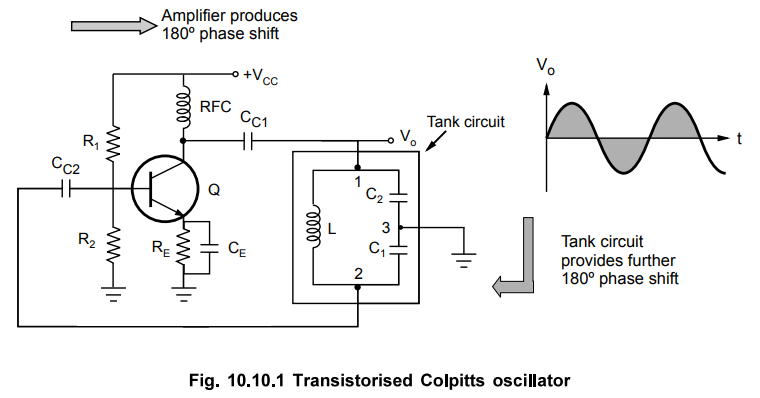
•
The amplifier stage uses BJT in common emitter configuration providing 180°
phase shift. The resistances R1 R2 and RE are the biasing
resistors.
•
The RFC is radio frequency choke providing isolation between a.c. and d.c.
operation. The CC1 and C C2 are coupling capacitors. In
the feedback circuit, as the centre of C1 and C2 is
grounded, it provides additional phase shift of 180°, satisfying Barkhausen angle
condition.
•
In this oscillator,
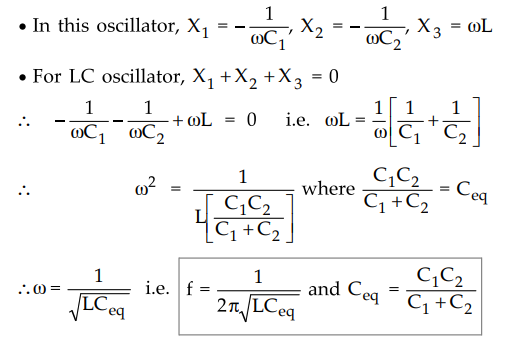
To
satisfy magnitude condition of Barkhausen criterion, the hfe of BJT used is
given by,
hfe
= C2 / C1
2. Derivation of Frequency of Oscillations
The
equivalent circuit and simplified equivalent circuit are shown in the Fig.
10.10.2.
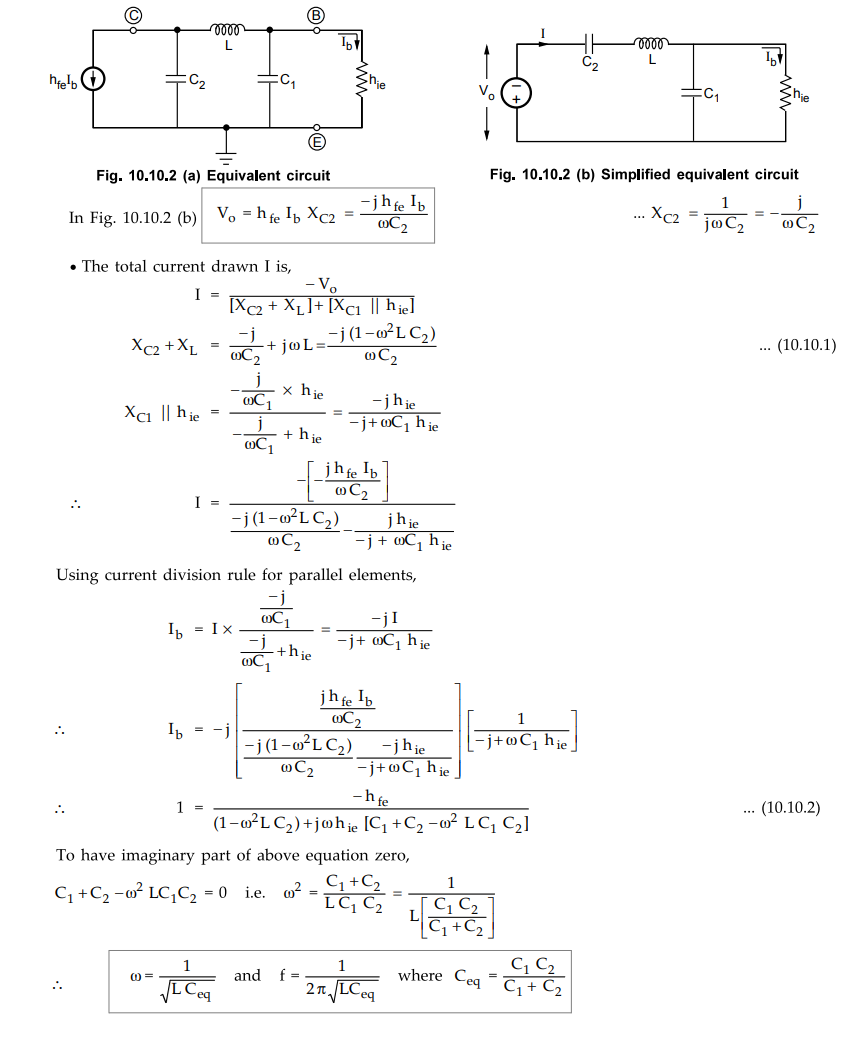
Substituting
ro in equation (10.10.2) and equating magnitudes of both sides,
hfe
= C2 / C1
Ex.
10.10.1 Find the frequency of the oscillations of a transistorised Colpitts
oscillator having Cj = 150 pF, C2 = 1.5 nF and L = 50 pH.
Sol.
:
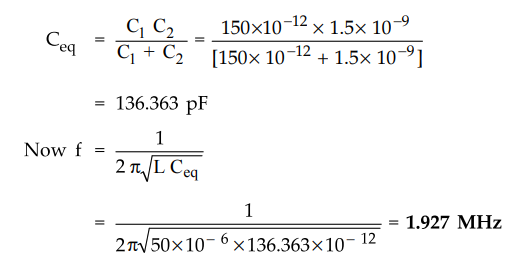
Ex.
10.10.2 In a Colpitt’s oscillator = 0.001 pF, C2 = 0.01 pF and L = 10 pH. Find
the frequency of oscillation, feedback factor and the voltage gain.
AU
: Dec.-04, Marks 6
Sol.
:
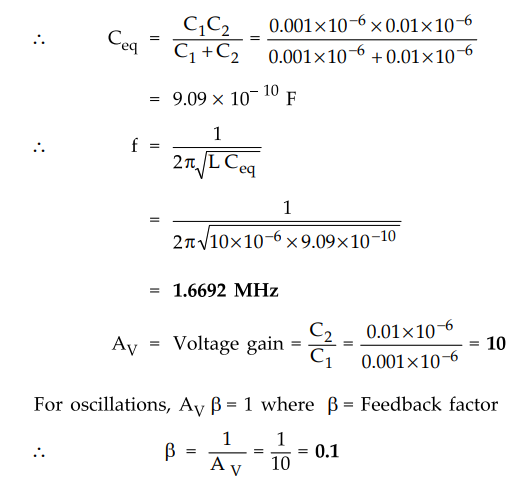
Ex.
10.10.3 In Colpitt’s oscillator C2 nF. If the frequency of oscillation is 100
kHz find the value of inductor. Also find the minimum gain required for
obtaining sustained oscillations.
Sol.
:
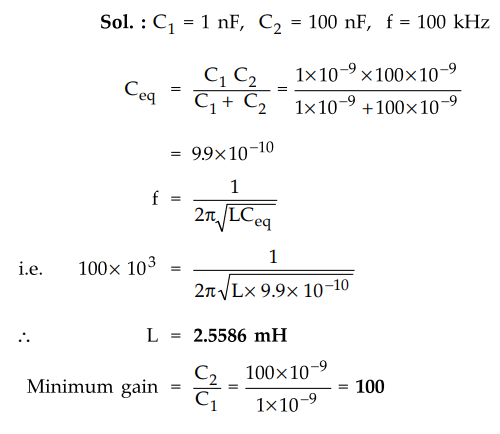
Ex.
10.10.4 A 1 mH inductor is available. Choose the capacitor values in a Colpitts
oscillator so that f=l MHz and feedback fraction is 0.25.
Sol.
:
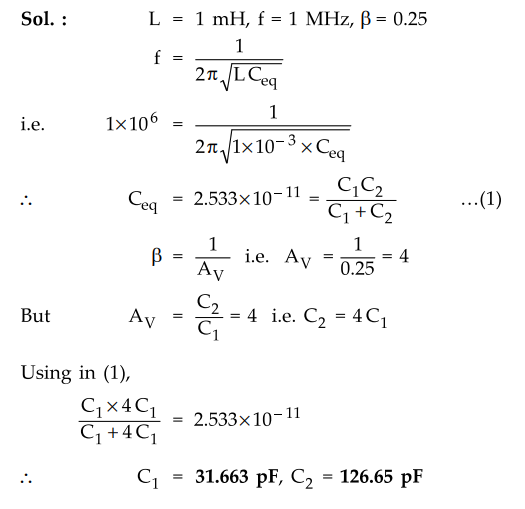
AU
: May-16, Marks 4
3. Advantages, Disadvantages and Applications
•
The advantages are,
i)
Pure output waveform.
ii)
Good stability at high frequency
iii)
Improved performance at high frequency
iv)
Wide range of frequency
v)
Simple construction
•
The disadvantages are,
i)
Difficult to adjust the feedback
ii)
Poor isolation.
•
Its main application is high frequency function generator.
Review Questions
1. Draw the neat circuit diagram of Colpitt's oscillator using
BJT and explain its operation.
AU : Dec-04, 09, Marks 8
2. In a Colpitt's oscillator C1 = 0.001 pF, C2 = 0.01 pF and L =
10 pH. Find the frequency of oscillation, feedback factor and the voltage gain.
(Ans.: 1.6692 MHz, 0.1,10)
3. A Colpitts oscillator is designed with C1 =100 pF and C2 =
7500 pF. The inductance is variable. Determine the range of inductance values,
if the frequency of oscillations is to vary between 950 kHz and 2050 kHz.
(Ans.: 61.07 µH to 284.41 µH)
4. Explain the operation of Colpitts oscillator with neat
circuit diagram. Also derive the expressions for the frequency of oscillation
and the condition for maintenance of oscillation.
Electron Devices and Circuits: Unit V: (b) Oscillators : Tag: : Types, Transistorised, Derivation of Frequency, Advantages, Disadvantages, Applications, Equivalent Circuit, Solved Example Problems - Colpitt's Oscillator
Related Topics
Related Subjects
Electron Devices and Circuits
EC3301 3rd Semester EEE Dept | 2021 Regulation | 3rd Semester EEE Dept 2021 Regulation
